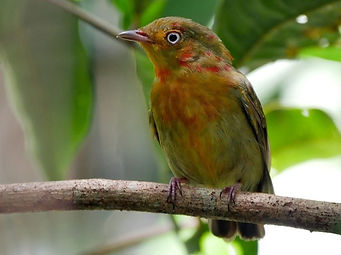
Western Bluebird
The Relatable Crimson-Hooded Manakin
When you look at this Crimson-Hooded Manakin, you see vulnerability

The crimson-hooded manakin, otherwise known as Pipra aureola, is a small South American bird growing only to about five inches in height. Like many tropical birds, the males are quite colorful with a bright red-orange head and belly with black wings, while the females display less flamboyant reddish-green feathers instead. Due to the manakin's small size, it is quite susceptible to predators, consisting mostly of harpy eagles and Amazon Tree Boas.
The Crimson-Hooded Manakin in the Orma J. Smith Museum of Natural History
Habitat
Due to the manakin having such a large range of habitat, it is not considered to be endangered. The bird can be found from the coastal areas of Eastern Venezuela, all the way down to the Amazon River estuary and continuing up the Amazon River for 1000 miles to Manaus. Unfortunately, after Europeans started residing in the Americas in the 1500s, every year more and more of the manakin’s habitat is being destroyed. Where there once was the bird’s natural habitat, there are now cities, farms, and deforestation.

Female Crimson-Hooded Manakin
Vulnerability
My mother has always told me that to foster growth and change, you need to be vulnerable. To the right is a picture of her and myself just before going into the hospital for knee surgery. She told me that I would never be the same person after I got out of surgery. At the moment I didn’t understand why, but now I have realized that it is because I mentally hit rock bottom after surgery. I was not the person I wanted to be; to get out of that hole, I had to be vulnerable and look myself in the mirror, diagnose the problem, ask how I got myself there and what I needed to do to become the person I wanted to be.

Male Crimson-Hooded Manakin

Range of the Crimson Hooded Manakin
Adaptability
With the crimson-hooded manakin’s habitat changing so much due to human civilization, it must be doing something right in order to keep its numbers at a stable rate. The manakin has adapted well to a human infested habitat. The bird has been able to thrive off flooded farms and deforested land brought about by mankind.

My mother and I just before surgery
Making a Change
Just as I took a hard look in the mirror to change myself for the better, a big key to fixing human effects on the climate is to open up and take a hard look in the mirror, diagnose where we went wrong, what we are doing wrong, and what we must do to steer ourselves in the right direction. If we can allow ourselves to be vulnerable--it will be the hardest thing we have ever done--but the sacrifices we have to make are far inferior to allowing vulnerable birds such as the crimson-hooded manakin to struggle and perish because of something out of their control.
